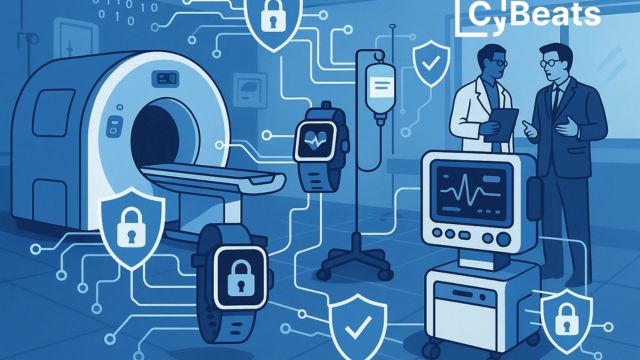Cybersecurity now ranks among the most important issues facing the healthcare industry in the linked world of today. Medical equipment is more susceptible to hackers as it gets more complex and linked with networked systems. Maintaining the integrity of healthcare systems, protecting private patient data, and guaranteeing the security of these devices depend mostly on clinical engineers. Let’s look at the essential steps clinical engineers take to guard medical equipment against cyberattacks and hacking.
The Growing Threat to Medical Devices
To provide best performance, medical equipment like pacemakers, insulin pumps, imaging tools, and diagnostic gadgets depends on software and network connectivity. Although this digital development improves healthcare quality, it also lets cybercriminals use weaknesses unfettered access.
Cyberattacks on medical devices can have devastating consequences, including the theft of sensitive patient data, manipulation of device settings, and in extreme cases, the complete failure of life-saving devices. In 2020, the U.S. Food and Drug Administration (FDA) issued a warning regarding cybersecurity vulnerabilities in more than 250 medical devices, highlighting the growing threat of hacking. This underscores the need for stringent cybersecurity measures to protect both patients and healthcare institutions.
You may like this: How Clinical Engineers Impact Healthcare Costs by Improving Equipment Efficiency
How Clinical Engineers Protect Medical Devices

Clinical engineers are at the forefront of ensuring the security of medical devices within healthcare facilities. Their responsibilities go beyond routine maintenance and calibration; they are also tasked with preventing cyber vulnerabilities. Here’s how they ensure that medical devices remain safe from cyber threats:
1. Risk Assessment and Vulnerability Management
Clinical engineers conduct regular risk assessments to identify potential cybersecurity vulnerabilities in medical devices. By evaluating each device’s software, hardware, and network interfaces, engineers can pinpoint weak spots and address them before they become security risks. Vulnerability management involves keeping up-to-date with software patches, firmware updates, and security advisories from manufacturers to mitigate threats.
2. Network Segmentation
One of the most effective cybersecurity strategies for medical devices is network segmentation. Clinical engineers ensure that medical devices are isolated from general hospital networks. By placing these devices on a separate, secured network, engineers prevent attackers from accessing sensitive data or controlling critical devices. For example, devices like patient monitors and infusion pumps are isolated from administrative systems, limiting the potential for a widespread attack.
3. Device Haoftware and Firmware Updates
Keeping medical device software and firmware updated is a vital part of cybersecurity. Clinical engineers work closely with manufacturers to ensure that devices receive timely updates to patch security vulnerabilities. These updates not only fix bugs but also address new and emerging security threats. Automated alerts and scheduling systems can help engineers monitor for available patches and apply them promptly to reduce exposure to cyberattacks.
4. Incident Response Planning
Despite all preventative measures, there is always the possibility of a cyberattack. Clinical engineers must be prepared with an incident response plan to minimize the impact of an attack. This plan includes predefined steps for isolating infected devices, investigating breaches, and restoring systems to normal operation. It also involves notifying relevant stakeholders, including healthcare providers, IT departments, and patients if necessary.
5. Data Encryption and Secure Communication Protocols
Medical devices often collect and transmit sensitive patient information. Clinical engineers ensure that all data transmitted by medical devices is encrypted using advanced encryption protocols. This ensures that even if hackers intercept the data, it remains unreadable. Secure communication protocols like HTTPS and VPNs are also implemented to protect patient data during transmission.
6. Employee Training and Awareness
Cybersecurity is not only the responsibility of clinical engineers but also healthcare professionals. Engineers play a role in training hospital staff on the importance of security when interacting with medical devices. Employees are educated on safe usage practices, such as not using personal devices on the medical network and recognizing phishing attempts. Educating staff about the risks and best practices is critical to preventing accidental breaches.
7. Collaboration with IT and Security Teams
Clinical engineers work in tandem with hospital IT and cybersecurity teams to implement a comprehensive security strategy. This collaboration ensures that medical devices align with the overall security infrastructure of the healthcare facility. By integrating security systems like firewalls, intrusion detection systems (IDS), and access control mechanisms, engineers ensure that medical devices are part of the broader protection framework.
The Role of Manufacturers in Securing Devices
While clinical engineers play a significant role in protecting medical devices, manufacturers also have a responsibility to design devices with cybersecurity in mind. The FDA and other regulatory bodies have guidelines for manufacturers to implement secure software development practices, conduct regular testing, and ensure that devices can be updated remotely. Manufacturers are expected to provide clinical engineers with comprehensive security documentation, including vulnerability reports, patch management procedures, and secure communication protocols.
You may like this: Clinical Engineering in Personalized Medicine: How Custom Devices Improve Treatment
Conclusion
In a time when cyber dangers are expanding exponentially, clinical engineers’ protection of medical equipment becomes increasingly more crucial. By means of risk assessments, network segmentation, device hardening, and ongoing monitoring, clinical engineers are enabling a safe environment for patients and healthcare practitioners. Clinical engineers make sure that medical devices keep operating as intended, without compromise by being alert and adjusting to emerging cybersecurity risks.
Stay current and updated about the newest developments in clinical engineering and medical device security, or Call to Action (CTA!). For insightful analysis, news, and tools to negotiate the changing landscape of medical supplies and clinical engineering, visit JandJSupplies.com. With the newest trends and professional guidance, guarantee the security of your devices and data.
FAQs
How can I prevent my medical devices from being hacked?
Regularly update the device’s software and firmware, use strong passwords, and implement network segmentation to isolate devices from general hospital networks. Device hardening and encryption of data are also essential for minimizing vulnerabilities.
What is the importance of network segmentation in medical devices?
Network segmentation isolates medical devices from other systems in a healthcare facility, reducing the risk of a cyberattack spreading to critical devices. This adds an extra layer of protection for sensitive medical data and devices.
How often should medical devices be updated for cybersecurity?
Medical devices should be updated regularly according to the manufacturer’s security patches and updates. Clinical engineers should ensure that updates are applied promptly to address known vulnerabilities.
What is an incident response plan for cyberattacks on medical devices?
An incident response plan outlines the steps to take in the event of a cyberattack, including isolating affected devices, conducting an investigation, restoring normal operations, and notifying relevant parties.
How can manufacturers help in securing medical devices?
Manufacturers are responsible for designing secure devices, providing regular updates, and supplying clinical engineers with documentation on security features, patches, and compliance with industry standards.








